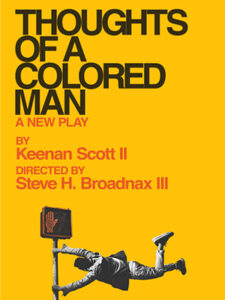

Thoughts of a Colored Man
Opening Night: October 13, 2021
Closing: March 20, 2022
Theater: Golden Theatre
As the sun rises on a single day in the pulsing heart of Brooklyn, seven Black men are about to discover the extraordinary – together. By Keenan Scott II, one of today’s boldest new voices, Thoughts of a Colored Man blends spoken word, slam poetry, rhythm, and humor into a daringly universal new play. Welcome to the vibrant inner life oQ being Black, proud, and thriving in the 21st century.
BUY TICKETSREAD THE REVIEWS:
October 13, 2021
One of them then asks the question that begins the play: “Who is the Colored Man?” It’s a question that Scott’s Broadway debut, which opened on Wednesday night at the John Golden Theater, doesn’t quite know how to answer. Incorporating slam poetry, prose and songs performed by its cast of seven, “Thoughts of a Colored Man,” which first premiered in 2019 at Syracuse Stage in a co-production with Baltimore Center Stage, aspires to be a lyrical reckoning with Black life in America but only delivers a gussied-up string of straw-man lessons.
READ THE REVIEWOctober 13, 2021
Love is often trapped in gummy lyricism (“The world fell silent as I listened to the internal instrumental my heartbeat made. As I came behind her, I touched her shoulder like the wind”), and with so many topics to cover, the characters are sometimes overwhelmed. Under Steve H. Broadnax III’s artful direction, however, the cast avoids falling too neatly into types, and Depression and Happiness emerge with particular individual clarity. When the play is at its best—when the rhythms kick into place, and the details pop, and the language sharpens to a cutting edge—one is grateful for the voices that Scott has brought to Broadway.
READ THE REVIEWOctober 13, 2021
And as worthy of applause as those productions were and are, all feel a bit like preamble to Keenan Scott II’s remarkable Thoughts of a Colored Man opens, the first fully realized reflection of the shutdown era. A play of immense compassion and keen insight, with a vise-grip on the dreams and disappointments of its characters, Thoughts of a Colored Man is a paean to life as both survival and celebration, a tribute and exploration of the Black men who find beauty, dignity, frustration and inspiration where they can.
READ THE REVIEWOctober 13, 2021
But where “For Colored Girls” assembles vivid and discrete portraits into a kind of cosmic ritual, Scott and Broadnax plant their kicks on the pavement, purveying a streetside take on the men’s daily lives and intersections. The result attempts an uneven sort of naturalism, as the men posit one purportedly universal truism after another, tracing the outlines of life in place of illuminating its substance. Scott’s mode of expositional storytelling can also grow to feel didactic, in a way that feels in conflict with efforts to ground the play in everyday reality.
READ THE REVIEWOctober 13, 2021
But while one may acknowledge its incidental flaws, the cumulative power of “Thoughts of a Colored Man” is what remains with you after the curtain falls. “But you don’t hear us though!” is the collective refrain all but shouted in the play’s final moments. At least for the play’s duration and probably for long after, audiences encountering Scott’s richly human characters will not only hear them, but see them and feel with them, too.
READ THE REVIEWOctober 13, 2021
Equity—true equity—is not about all races winning equally. In fact, this equity comes only when all races are allowed to fail at the same rate, to produce mediocre art and yet be given the space to be audacious enough to keep making art with expectations of finding an audience. Thoughts of a Colored Man falters in many places, as most plays written and directed by debutantes often do. It now rests upon the industry to rise to its promises and hold the space for these Black men (and the many they will inspire) to keep making these mistakes till the day they don't anymore.
READ THE REVIEW

























